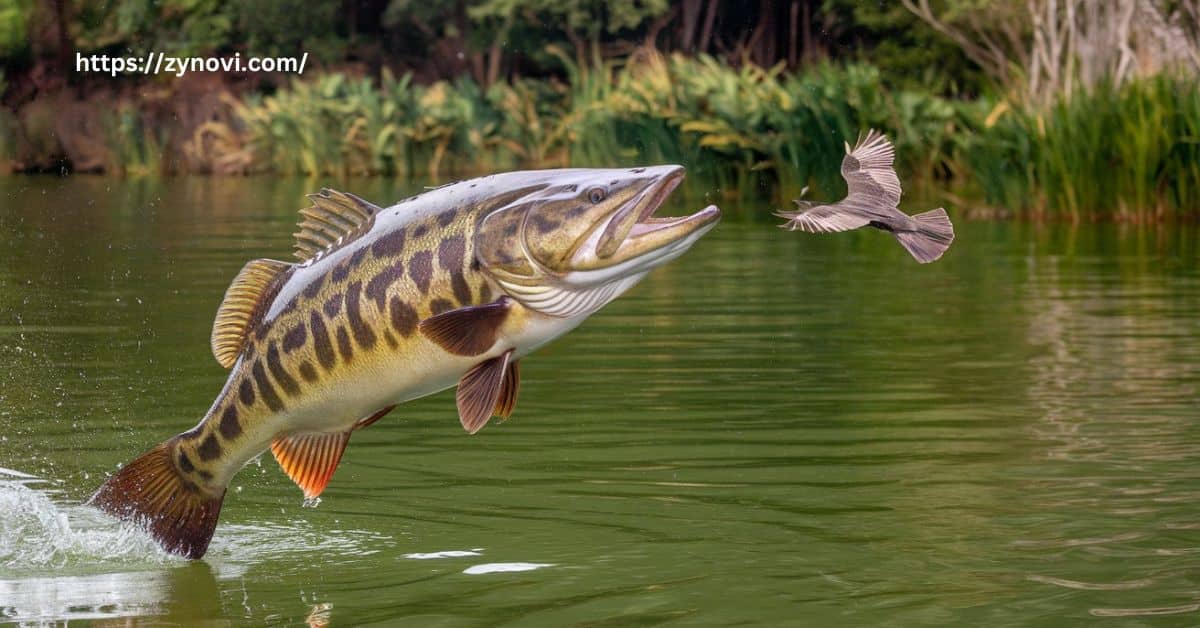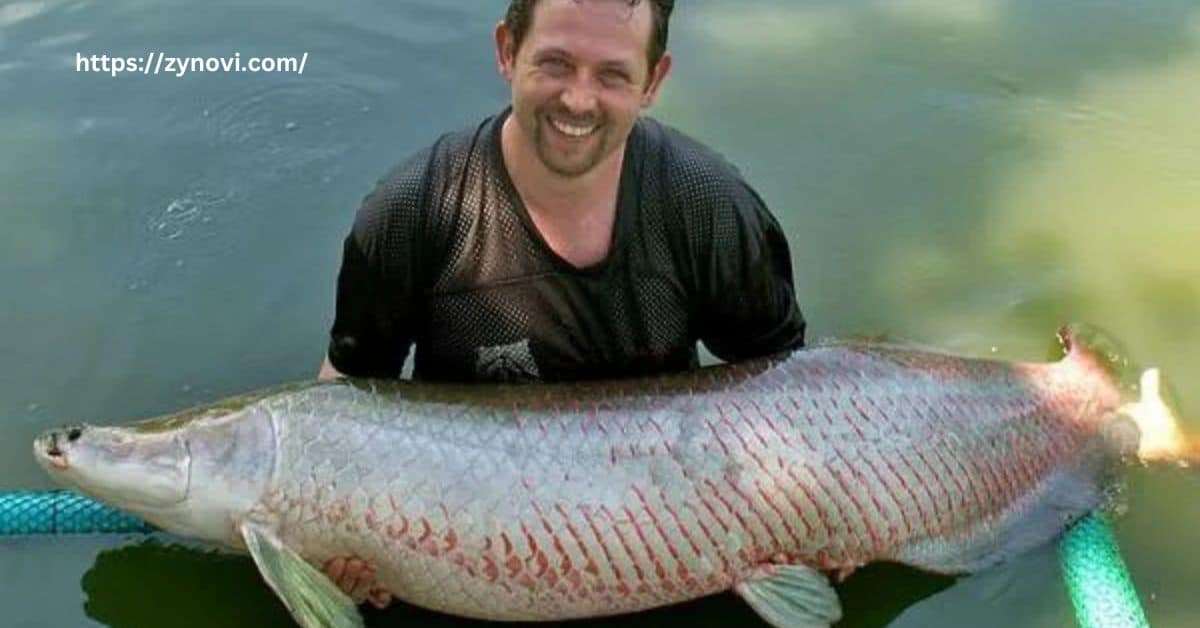Do Arapaima Attack Humans? Arapaima rarely pose a threat; instead, they usually steer clear of encounters and are far from aggressive.
This is a question many people have when they first hear about the giant fish that roams the Amazon River. These freshwater giants, known for their massive size, often spark curiosity and concern especially when it comes to their behavior toward humans.
But don’t worry, while arapaima can be intimidating due to their size, they’re actually more likely to avoid you than attack. In this article, we’ll explore the truth behind their behavior, clarify common myths, and share how you can safely enjoy these magnificent creatures in their natural habitat. Keep reading!
What Is an Arapaima?
The Arapaima (also known as Pirarucu or Paiche) is a giant fish that calls the Amazon River Basin home. Known for its remarkable size and unique breathing adaptations, the arapaima is truly one of the largest freshwater fish in existence.
Physical Characteristics
Here is the information about the Arapaima’s physical characteristics in table form:
| Characteristic | Details |
|---|---|
| Size | Can grow up to 10 feet in length and weigh over 400 pounds. |
| Body Features | Has an elongated body, large armor-like scales, and a broad head. |
| Breathing Adaptation | Modified swim bladder acts as a lung-like organ, allowing it to surface every 15 to 20 minutes to breathe. |
Natural Habitat and Range
These unique physical characteristics enable the arapaima to thrive in the challenging conditions of the Amazon River.
Its ability to survive in warm, slow-moving waters with low oxygen levels is facilitated by its modified swim bladder, which functions like a lung.
This adaptation allows the arapaima to surface every 15 to 20 minutes for air, making it well-suited for floodplains, lakes, and other oxygen-deprived aquatic environments where many other fish might struggle to survive.
Do Arapaima Attack Humans?

There is a common misconception that the arapaima may attack humans, but this is largely a myth. These fish are generally non-aggressive and wary of humans.
However, like any wild animal, they may display defensive behaviors under certain circumstances. Let’s break down how arapaima interact with humans and what the real risks are.
Behavior Around People
In the wild, arapaima are not known to be aggressive towards humans. They are primarily concerned with finding food, not attacking larger creatures.
The arapaima’s diet includes small fish, crustaceans, and occasionally small birds or mammals. They do not view humans as prey, and their instinct is to avoid human contact.
However, arapaima can become startled if approached too closely or unexpectedly. In such cases, they may flee, or if confined or cornered, they could display some defensive behaviors such as thrashing their tails or creating large splashes.
This can cause accidental injuries, but these are not the result of predatory aggression.
Notable Encounters with Humans
- Historically, there have been very few documented cases of arapaima attacks on humans. Instead, interactions with arapaima are often peaceful.
- In the Amazon, arapaima fishing practices have existed for centuries, and local communities have coexisted with these fish without major conflict.
- However, accidental injuries sometimes occur during fishing activities. Arapaima can be quite large, and when they thrash or become hooked, they may unintentionally injure fishermen or bystanders.
- Though these occurrences are rare, they serve as reminders that arapaima, like any wild animal, should be treated with respect and caution. The key is maintaining a safe distance and avoiding direct contact.
Potential Dangers
So, can arapaima harm humans? While the risk of an arapaima attack is virtually nonexistent, the fish can still pose some dangers in certain scenarios:
- Thrashing and Tail Strikes: An arapaima’s tail is strong and powerful. If the fish feels threatened or is startled, it may strike out with its tail, which can lead to injuries such as bruising or cuts. These incidents typically occur when the fish is accidentally cornered or caught during fishing.
- Accidental Injuries: While arapaima are not predatory, their sheer size means they can cause accidental harm if they collide with a person while swimming or in a confined space. The risk of injury is higher in areas where arapaima are handled for commercial purposes, like tourism or fishing, so proper handling techniques should always be followed.
However, it’s important to note that there are no documented cases of arapaima being venomous or seeking out human prey.
Causes of Arapaima Aggression

While the arapaima is generally peaceful, there are certain circumstances under which it might become defensive. Understanding these triggers is crucial for avoiding dangerous interactions.
Environmental Stressors
The arapaima‘s natural habitat is being increasingly impacted by human activities, such as pollution and overfishing. These pressures can cause stress, and in some cases, may make the fish more inclined to react defensively if approached.
It’s important to remember that like all wild animals, they will defend themselves if they feel threatened or cornered.
Misunderstandings in Close Proximity
An arapaima may mistake an approaching person for a threat, especially if they are in a confined area or if the fish feels trapped. For example, an arapaima in a fishing net or while being lifted from the water could thrash out of defensive instinct.
However, these reactions are generally not attacks but attempts to escape perceived danger.
Cultural Importance of Arapaima
The arapaima plays an integral role in the cultural and economic landscape of the Amazon. For centuries, indigenous tribes have relied on this majestic fish as both a food source and a central figure in folklore and spiritual beliefs.
Role in Local Communities
In many Amazonian cultures, arapaima fishing is not just a way of life it is a sacred tradition. These fish are often seen as protectors of the river and a symbol of abundance.
Local communities value the arapaima for its meat, which is a staple food source in the region. The scales and bones are used in traditional crafts, and the fish is deeply tied to the identity of many Amazonian tribes.
Arapaima in Modern Conservation
While the arapaima has been historically overfished, there have been significant efforts in recent years to promote sustainable fishing practices.
These efforts have aimed to protect the species from extinction and ensure it remains a vital part of both the ecosystem and the local economy.
In some regions, the fish is now protected by law, and conservation programs have been set up to help ensure the arapaima’s survival for future generations.
How to Stay Safe Around Arapaima

If you find yourself near an arapaima in the wild or during a fishing expedition, it’s essential to understand how to safely interact with this magnificent creature.
Best Practices for Viewing Arapaima Safely
- Keep a Safe Distance: The best way to avoid injuries is by maintaining a respectful distance from the fish. Always be mindful of your surroundings when swimming or fishing in areas where arapaima are present.
- Don’t Startle the Fish: Sudden movements or loud noises can cause the fish to react defensively. Avoid making abrupt gestures or disturbing the water.
- Use Proper Fishing Gear: If you’re fishing for arapaima, make sure you’re using the correct fishing techniques and equipment. Handle the fish gently, and avoid unnecessary stress or injury to the animal.
What to Do in Case of an Aggressive Encounter
If you ever find yourself in a situation where an arapaima appears agitated or startled, follow these steps:
- Stay Calm: Panicking can make the situation worse. Keep your movements slow and steady to avoid startling the arapaima further. By staying calm, you help reduce the likelihood of the fish feeling threatened or cornered.
- Slowly Move Away: If you’re in the water, don’t make any sudden movements. Slowly swim away, ensuring you give the arapaima plenty of space to retreat. This minimizes any chances of it feeling trapped or aggressive.
- Avoid Physical Contact: Never attempt to touch or grab the arapaima. Its large size and powerful thrashes can cause injury. Handling or provoking the fish could lead to an accidental strike from its strong tail, resulting in harm for both you and the fish.
Final Verdict
In short, no, arapaima do not attack humans. These giant fish are peaceful by nature and will usually avoid human contact. Aggressive behaviors are rare and typically only occur if the fish feels threatened or cornered.
When treated with respect and approached cautiously, arapaima can coexist with humans without incident. It’s essential, however, to understand the fish’s behavior and habitat to minimize any potential risks. Arapaima safety is primarily about respectful interaction and proper precautions.
FAQs
Can arapaima hurt people?
Arapaima are not aggressive but may cause accidental injuries with strong tail thrashes if provoked or handled improperly.
How aggressive are arapaima?
Arapaima are generally non-aggressive and tend to avoid humans unless they feel threatened or cornered.
Do humans eat arapaima?
Yes, arapaima are an important food source in local communities, particularly in the Amazon, and are often consumed through sustainable fishing practices.
Do arapaima fight hard?
Arapaima are strong swimmers and may put up a powerful resistance when caught, but they are not known for aggressive fighting behavior.
Conclusion: Do Arapaima Attack Humans?
In conclusion, the arapaima is a remarkable creature of the Amazon River, known for its size and fascinating behavior. While it is certainly capable of displaying defensive actions if threatened, these freshwater giants are generally not inclined to attack humans.
Most encounters with arapaima result in the fish retreating rather than engaging in aggression. By respecting their space and understanding their natural behavior, you can safely observe these magnificent fish. With the right approach and a mindful attitude, you can appreciate the arapaima as a vital part of the Amazon’s diverse and intricate ecosystem.










